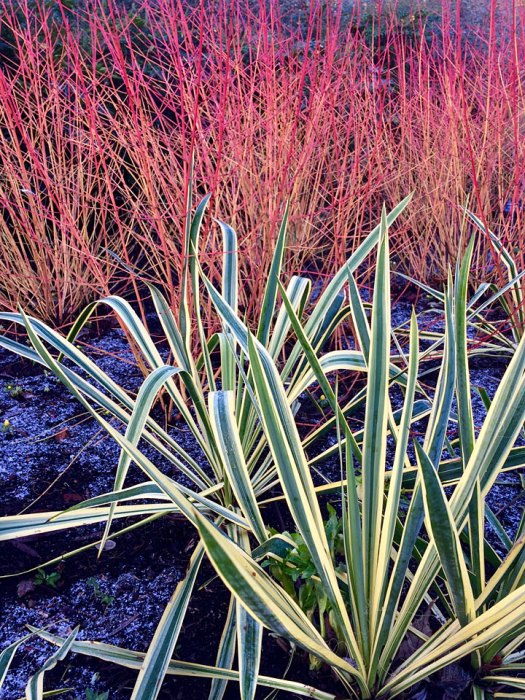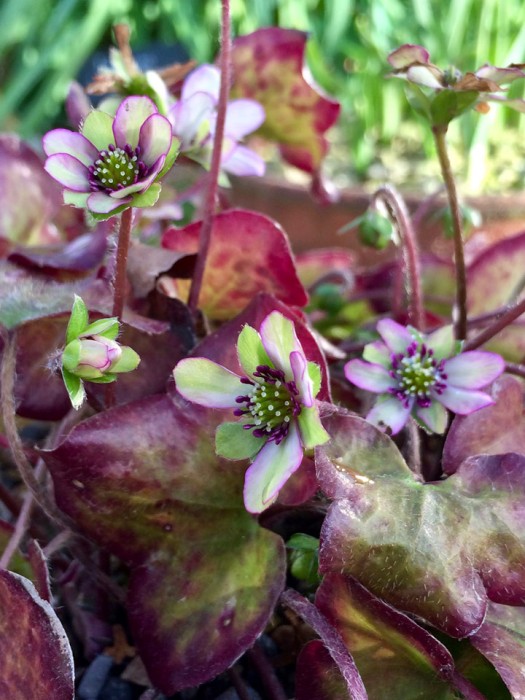
We set off for Harrogate on a whim, inspired by the weather forecast, and booked into a hotel within walking distance from the RHS’s most northerly garden, Harlow Carr, a favourite haunt. The idea was to wake up next morning to find an artistic covering of snow or a hard frost – the added winter garden ingredients only nature can provide.
The forecast had been an exaggeration but, luckily, it turns out that a winter wonderland doesn’t need snow: it can cloak itself just as wonderfully in reds, oranges, browns and greens.

We were too early to see the thousands of snowdrops, cyclamen, irises and eranthis hyemalis that will be at their peak in February and March. A small number of the advance guard could be spotted in flower in the woods, along the Winter Walk or sheltered in the glasshouse, giving a hint of the pleasure to come. But if you find yourself wondering whether a winter garden really has anything much of interest to offer in January, other than peace, you’ll find plant after plant lining up as if to say: ‘You misjudged me. You doubted there would be colour.’
The garden seemed full of birds, including the European robin (Erithacus rubecula), which is smaller, rounder and more orange than the American robin. Our robin redbreast is the most companionable of wild birds, happy to trade the risks of getting up close to a gardener for the chance of finding a worm. This little creature was fluffing his (or her) feathers against the cold, and was unfazed by a large creature looming over in breathless excitement to be able to get close enough for long enough to capture a decent iPhone picture.

Weak, early morning sunlight added a little magic to the formal water garden, making the film of ice on the water gleam, glancing off the walls and broken paving and highlighting the feathery seed heads left on the clematis stems. Beautiful at any time of the year, my only sadness is that the water garden is closed off by rows of potted plants to prevent visitors from falling in the water, so can only be admired from afar.

Harlow Carr is a teaching garden at heart. Interesting plant combinations are all around. Some areas are demonstration gardens, showing how to make a year-round garden in a small space; how to make little steps to help hedgehogs escape from ponds; how to grow vegetables and edge beds; how to support climbing plants, etc. My sweetheart claims he never visits the garden without coming away with some new ideas.

It’s child-friendly too, with a tree house and a play area. The garden has a sculpture trail which is expanded during some months, but has some permanent exhibits, such as the wicker Big Friendly Giant that towers amongst the trees.
In winter, our focus naturally shifts to the structure of a garden. We see the naked form of trees and admire the colour of the bark, branches and stems – some palely loitering, others bronzed, glossy and bold.


Another favourite place is the glasshouse where some of the more delicate specimens are displayed while at the peak of bloom. The plants are grown in clay pots sunk in sand to keep their roots cool and are watered with rainwater, harvested from the roof and guttering.

I find myself liking winter gardens more and more. We were grateful that Garden Manager Katherine Musgrove took time out of her busy schedule to talk to us. She suggested we might enjoy a book called Winter Gardens: Reinventing The Seasons by Cedric Pollet, and she was right. Don’t so much as glimpse in this book if you don’t want to be tempted to visit winter gardens. We each browsed through a copy in the bookshop (a treasure trove of gardening books) and after several rapt minutes of calling out ‘Have you seen page 82?’… ‘and page 114?’…, ‘Just look at page 46!’, we’ve added several more winter gardens to our to-visit list.
If you’re intrigued to find out more about Harlow Carr, take a look at the RHS website or browse through my earlier Harlow Carr posts (pictures don’t appear in this list view, but all is revealed when you click on the title of the post).







Your photos are so gorgeous! What wonderful colors. Gardens that look so pretty in the winter are, I think, the test of a true master gardener/garden designer.
I agree. It helps that Harlow Carr is a decent size and so well laid out. Some parts of the garden are massed swathes of seedheads now, which is just as attractive, in a very natural way and the birds must love the bounty.
Inspiring garden and beautiful photos
Thank you.
Thanks for posting – well worth a visit soon.
My pleasure.
When I saw the first beautiful picture, I almost choked on my hot cocoa. Winter garden? That would be a spring or fall garden in Maine. 😉 All is white here and will be until the end of March. Just like in Toronto.
Sorry, Laurie. Your snow looks very beautiful to me.
That’s the great thing about blogging—seeing pictures from other parts of the world.
I agree – you get the feeling that every season is going on at the same time.
Yes! And our own place is just one small piece of a much bigger world.
Yucca! That does not seem to be very popular elsewhere.
I often see them on my travels. I am surprised they are hardy – they always have an exotic look, especially when they’re in bloom.
Exotic? I think they are unpopular here because one species is too common. I think that people think that the other species look cheap because the resemble the common one. I still dig them, especially here where we should be growing things that do not need much water.
I’ve always thought gardens are dull and boring in winter but you’ve proved me wrong with this one. It’s lovely, such beautiful colours and great photos – and I love the robin, he/she is really cute 🙂
I might have said the same a decade or so ago, but now winter gardens are something I look forward to. The robin was sweet – I have another picture with him/her standing just a few inches from my feet, but you couldn’t see the red breast on that one.
Thank you for the snowdrops! I remember them from my childhood in England, and have seen them only a few times in the U.S. Once was at Mt. Vernon, George Washington’s home, on his birthday, February 22, when the facility has free admission. Great memories!
It’s funny how evocative flowers are. I’m glad my pictures conjured up some happy memories.
Lovely spot – I love the look of the red and gold cornus. I need to plant some!
Cornus is a winter garden staple – it even looks good along the motorway. I think I prefer the red and gold to the yellow ones.
have seen some snowdrops in the hedge opposite me – should have some in the garden soon – if the chickens haven’t spoilt them!
My fingers are crossed they haven’t!
Beautiful post and photos. I’m planning a trip up to Harlow Carr in the next few days. The Hepatica is stunning. Might have to call in Betty’s for lunch also…
We stopped in, but just for a coffee. The hepatica picture is my favourite from the visit.